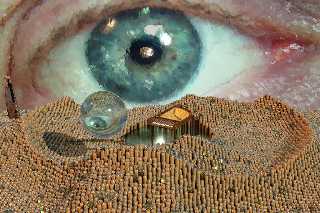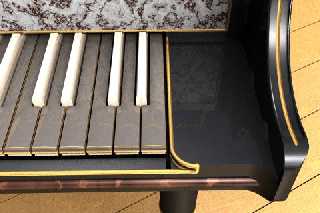 |
 |
|
 |
|
 |
|  |
|  |
|
 |
|
 |
|  |
|  |
|
 |
Hi,
I resumed work on the image I submitted to the Sep - Oct
2002 IRTC. After adding radiosity and photons, the result
was much too white so I changed the material of the terrain
from white stone to light wood randomly mixed with dark wood.
The present terrain consists of just two types of elements:
about 15,600 light wood cylinders with dark silver knobs and
780 dark wood cylinders with a thin golden torus at the top
and a small glass sphere hanging slightly above the top end.
All the colour differences are caused by the illumination,
either directly by the colour of the surrounding lights or
else by reflection and refraction. The soft reflections below
the harpsichord are caused by multiple reflections between two
plates of glass. The flute is illuminated in varying degrees
by the light refracted by the sphere above it.
The eye is a composite of a small segment of a photograph and
a glass sphere on the iris to reflect the lights in a more
natural way. There is a bozo height field glass plate in front
of the eye so I can render the image at 7620x5080 without fear
of all too obvious pixelation (the original is about 400 pixels
wide only).
Veijo
Post a reply to this message
Attachments:
Download 'arietta_2.jpg' (291 KB)
Preview of image 'arietta_2.jpg'

|
 |
|  |
|  |
|
 |
|
 |
|  |
|  |
|
 |
Veijo,
May or may not be the reaction you are after, but I presonally find this image
very unsettling. Even after thinking about it a bit I am not sure why. Good
work! :-) The keys on the keyboard appear to have merged in the posted image,
but I expect the keyboard looks OK at the larger resolution?
Regards, Bill
> ------------------------------------------------------------------------
>
Post a reply to this message
|
 |
|  |
|  |
|
 |
|
 |
|  |
|  |
|
 |
Veijo:
Awesome. Very nice combination of realism and the fantastic.
I am inspired to try something like this on my own.
Aaron
"Veijo Vilva" <vei### [at] animal helsinki helsinki fi> wrote in message
news:3ec640c8@news.povray.org...
> Hi,
>
> I resumed work on the image I submitted to the Sep - Oct
> 2002 IRTC. After adding radiosity and photons, the result
> was much too white so I changed the material of the terrain
> from white stone to light wood randomly mixed with dark wood.
> The present terrain consists of just two types of elements:
> about 15,600 light wood cylinders with dark silver knobs and
> 780 dark wood cylinders with a thin golden torus at the top
> and a small glass sphere hanging slightly above the top end.
>
> All the colour differences are caused by the illumination,
> either directly by the colour of the surrounding lights or
> else by reflection and refraction. The soft reflections below
> the harpsichord are caused by multiple reflections between two
> plates of glass. The flute is illuminated in varying degrees
> by the light refracted by the sphere above it.
>
> The eye is a composite of a small segment of a photograph and
> a glass sphere on the iris to reflect the lights in a more
> natural way. There is a bozo height field glass plate in front
> of the eye so I can render the image at 7620x5080 without fear
> of all too obvious pixelation (the original is about 400 pixels
> wide only).
>
> Veijo
>
----------------------------------------------------------------------------
---- fi> wrote in message
news:3ec640c8@news.povray.org...
> Hi,
>
> I resumed work on the image I submitted to the Sep - Oct
> 2002 IRTC. After adding radiosity and photons, the result
> was much too white so I changed the material of the terrain
> from white stone to light wood randomly mixed with dark wood.
> The present terrain consists of just two types of elements:
> about 15,600 light wood cylinders with dark silver knobs and
> 780 dark wood cylinders with a thin golden torus at the top
> and a small glass sphere hanging slightly above the top end.
>
> All the colour differences are caused by the illumination,
> either directly by the colour of the surrounding lights or
> else by reflection and refraction. The soft reflections below
> the harpsichord are caused by multiple reflections between two
> plates of glass. The flute is illuminated in varying degrees
> by the light refracted by the sphere above it.
>
> The eye is a composite of a small segment of a photograph and
> a glass sphere on the iris to reflect the lights in a more
> natural way. There is a bozo height field glass plate in front
> of the eye so I can render the image at 7620x5080 without fear
> of all too obvious pixelation (the original is about 400 pixels
> wide only).
>
> Veijo
>
----------------------------------------------------------------------------
----
Post a reply to this message
|
 |
|  |
|  |
|
 |
|
 |
|  |
|  |
|
 |
William F. Pokorny wrote:
> Veijo,
> May or may not be the reaction you are after, but I presonally find this
> image very unsettling. Even after thinking about it a bit I am not sure
> why. Good work! :-)
Thanks.
It is supposed to be something _different_. I've rendered the original
version at a resolution of 7620x5080 and had a photographic print made
at 254dpi (i.e. 30"x20", that's 76.2cm x 50.8 cm). It sure attracts
attention. This version I'm now rendering at a resolution of 6000x4000
only as I must have a print made before June 15th, and it takes about
three weeks to render at that resolution with a 2.4GHz P4.
> The keys on the keyboard appear to have merged in
> the posted image, but I expect the keyboard looks OK at the larger
> resolution?
Yeah, it's impossible to have all the details visible at the screen
resolution. However, I design everything so that I can go very near
the models without things starting to fall apart. I've attached a
close-up of the keyboard, and you can find more pics at my gallery:
http://www.animal.helsinki.fi/people/vilva/gallery/
Veijo
Post a reply to this message
Attachments:
Download 'keyb.jpg' (35 KB)
Preview of image 'keyb.jpg'

|
 |
|  |
|  |
|
 |
|
 |
|  |
|  |
|
 |
Very nice. Can you describe how you did the eye? No post processing in
Photoshop?? {:-)
Best.
D.
"Veijo Vilva" <vei### [at] animal helsinki helsinki fi> wrote in message
news:3ec640c8@news.povray.org...
> Hi,
>
> I resumed work on the image I submitted to the Sep - Oct
> 2002 IRTC. After adding radiosity and photons, the result
> was much too white so I changed the material of the terrain
> from white stone to light wood randomly mixed with dark wood.
> The present terrain consists of just two types of elements:
> about 15,600 light wood cylinders with dark silver knobs and
> 780 dark wood cylinders with a thin golden torus at the top
> and a small glass sphere hanging slightly above the top end.
>
> All the colour differences are caused by the illumination,
> either directly by the colour of the surrounding lights or
> else by reflection and refraction. The soft reflections below
> the harpsichord are caused by multiple reflections between two
> plates of glass. The flute is illuminated in varying degrees
> by the light refracted by the sphere above it.
>
> The eye is a composite of a small segment of a photograph and
> a glass sphere on the iris to reflect the lights in a more
> natural way. There is a bozo height field glass plate in front
> of the eye so I can render the image at 7620x5080 without fear
> of all too obvious pixelation (the original is about 400 pixels
> wide only).
>
> Veijo
>
----------------------------------------------------------------------------
---- fi> wrote in message
news:3ec640c8@news.povray.org...
> Hi,
>
> I resumed work on the image I submitted to the Sep - Oct
> 2002 IRTC. After adding radiosity and photons, the result
> was much too white so I changed the material of the terrain
> from white stone to light wood randomly mixed with dark wood.
> The present terrain consists of just two types of elements:
> about 15,600 light wood cylinders with dark silver knobs and
> 780 dark wood cylinders with a thin golden torus at the top
> and a small glass sphere hanging slightly above the top end.
>
> All the colour differences are caused by the illumination,
> either directly by the colour of the surrounding lights or
> else by reflection and refraction. The soft reflections below
> the harpsichord are caused by multiple reflections between two
> plates of glass. The flute is illuminated in varying degrees
> by the light refracted by the sphere above it.
>
> The eye is a composite of a small segment of a photograph and
> a glass sphere on the iris to reflect the lights in a more
> natural way. There is a bozo height field glass plate in front
> of the eye so I can render the image at 7620x5080 without fear
> of all too obvious pixelation (the original is about 400 pixels
> wide only).
>
> Veijo
>
----------------------------------------------------------------------------
----
Post a reply to this message
|
 |
|  |
|  |
|
 |
|
 |
|  |
|  |
|
 |
Very artistic, clever and good modelling too! I really like this.
Post a reply to this message
|
 |
|  |
|  |
|
 |
|
 |
|  |
|  |
|
 |
Dennis Miller wrote:
> Very nice. Can you describe how you did the eye? No post processing in
> Photoshop?? {:-)
No post-processing what so ever, I never do.
Here is the relevant part of the code, with some comments.
I hope this helps.
Veijo
box { <0,0,0>, <1,1,0.01>
pigment { image_map { tga "eye.tga" } } // the eye photo,
// which is a straight crop from a larger photo
translate <-0.5,-0.5,0> scale <1.5,1,1>
// translate to the origin, restore format to 3:2
rotate 18.5*x translate <0,-0.09,1> } // rotate to correct
// for the perspective as the camera isn't quite horizontal
sphere { <-0.06,-0.1,1.02> 0.03 texture { T_Gold_3C } }
// NB. this sphere is there just for a visual effect
sphere { <-0.07,-0.145,1.18> 0.295
// for the iris reflections
// position and dimensions empirical
texture { T_Glass3 } interior { I_Glass } }
// actually, these two spheres ought to be unioned
// with the photo before the corrective rotation
union { // this does the job
height_field {
tga "hf2b.tga" // a bozo height field
smooth scale <2, 0.015, 2> }
box { <0,-0.101,0>, <20,-0.098,15> }
// something like this seems to be required to make the HF work
rotate -90*x translate <-1,-1,0.7>
pigment { rgbt <1,1,1,1> } interior { ior 1.05 }
// the ior value is empirical, modify ad lib
}
Post a reply to this message
|
 |
|  |
|  |
|
 |
|
 |
|  |
|
 |




![]()